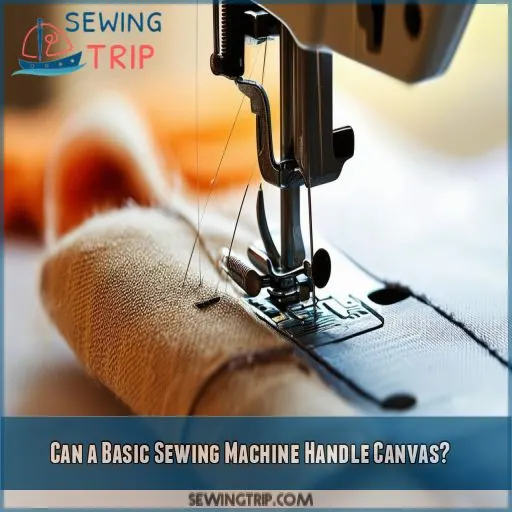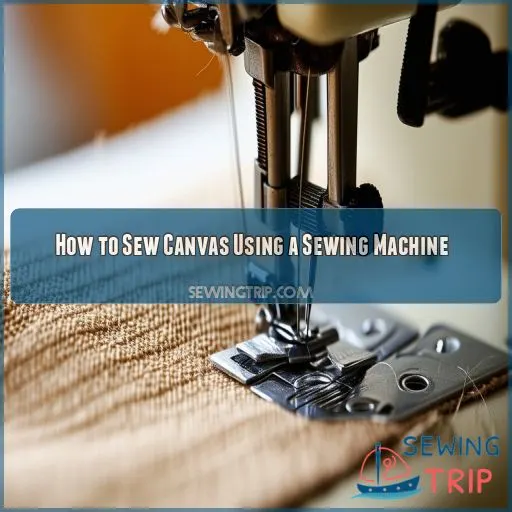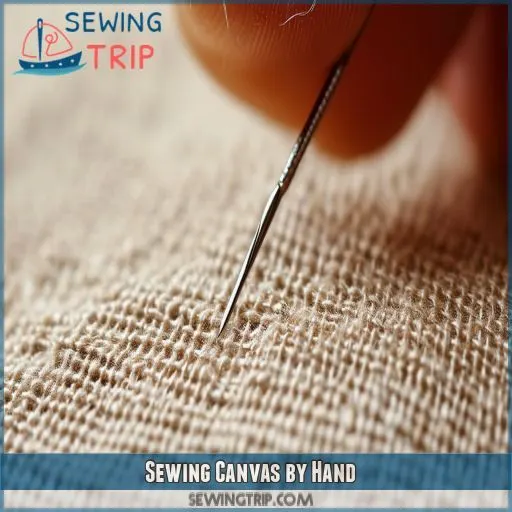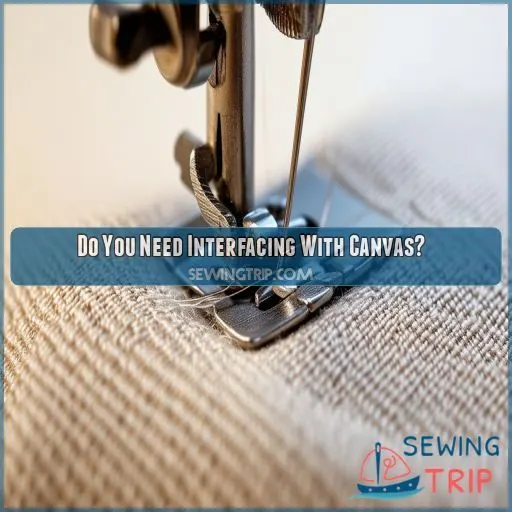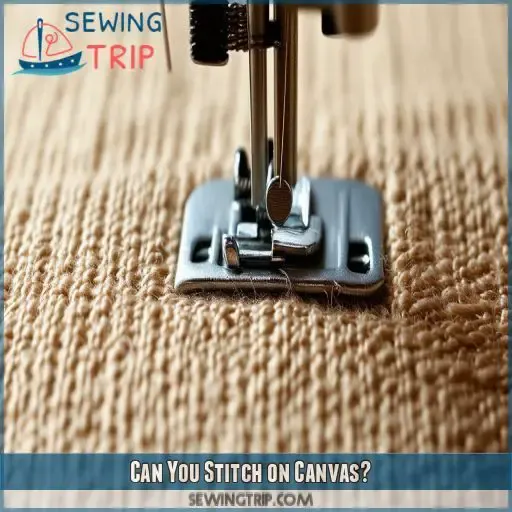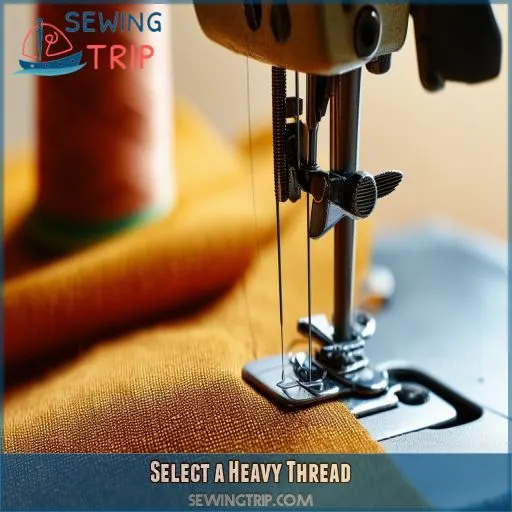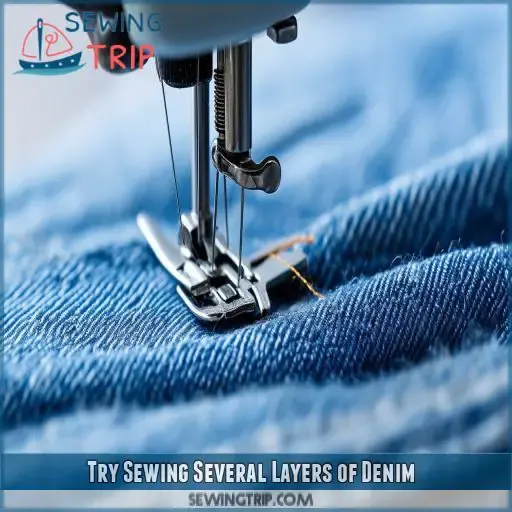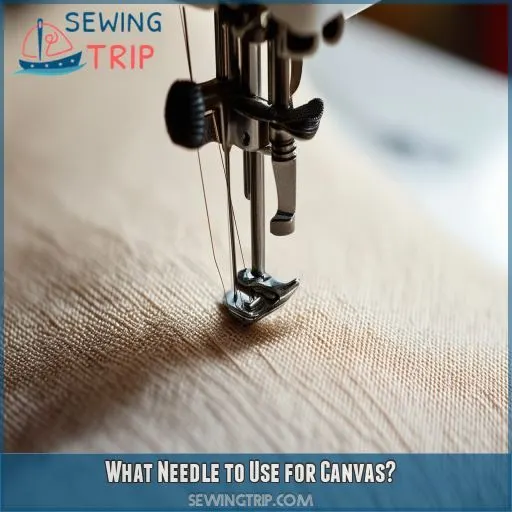This site is supported by our readers. We may earn a commission, at no cost to you, if you purchase through links.

You’ve set your sights on canvas, that rugged terrain of textiles.
Can your regular machine conquer this tough terrain? Absolutely!
You can sew canvas with a regular sewing machine, and we’ll show you how.
With the right tools and techniques, you’ll master this durable fabric in no time.
Get ready to explore new creative possibilities and take control of your sewing projects with canvas.
Table Of Contents
- Key Takeaways
- Can a Basic Sewing Machine Handle Canvas?
- How to Sew Canvas Using a Sewing Machine
- What is the Best Stitch for Canvas?
- Sewing Canvas by Hand
- Do You Need Interfacing With Canvas?
- Can You Stitch on Canvas?
- Select a Heavy Thread
- Try Sewing Several Layers of Denim
- Can You Sew Canvas With a Regular Sewing Machine?
- What Needle to Use for Canvas?
- Frequently Asked Questions (FAQs)
- Conclusion
Key Takeaways
- You can sew canvas with a regular sewing machine, but it depends on your machine’s capabilities and the thickness of the canvas. Start with lighter canvas fabrics and work your way up.
- Use the right tools for the job: heavy-duty needles, strong thread, and a walking foot will make sewing canvas a breeze.
- Adjust your machine’s settings: a longer stitch length, slower speed, and reinforced stitches will help you tackle this durable fabric.
- Don’t be afraid to give it a try! With the right techniques and a bit of practice, you’ll be stitching canvas like a pro, opening up a world of creative possibilities.
Can a Basic Sewing Machine Handle Canvas?
You might be surprised, but your basic sewing machine can often handle canvas! It’s not just reserved for heavy-duty machines.
The key is understanding your machine’s limits and making the right adjustments.
Start by checking if your home sewing machine can tackle four layers of denim. If it breezes through, you’re in luck! Canvas won’t be a problem.
But don’t push your machine too hard; forcing it could lead to damage.
Adjust your sewing needle, thread, and machine tension to accommodate the thicker fabric. A size 100/16 or 110/18 needle paired with heavy-duty thread will work wonders.
With a bit of practice, you’ll be stitching canvas like a pro in no time!
How to Sew Canvas Using a Sewing Machine
To sew canvas on a regular sewing machine, you’ll need to gather the right equipment and prepare your fabric properly. Start by assembling heavy-duty needles and thread, then pre-wash your canvas to prevent shrinkage before marking, cutting, and following general sewing techniques for best results.
Gather Your Equipment
You’ll need the right gear to tackle canvas sewing like a pro. Here’s what you should gather:
- A sturdy sewing machine with adjustable settings
- Heavy-duty needles (size 100/16 or 110/18)
- Strong thread (polyester or cotton-wrapped polyester)
- A walking foot for smooth fabric feeding
Don’t forget your marking and cutting tools:
- soapstone pencils or washable markers
- Sharp scissors or rotary cutter
- Sturdy cutting mat
- Clips or double-sided tape (instead of pins)
Prepare Fabric
Now that you’ve gathered your equipment, it’s time to prep your canvas fabric.
Start by pre-washing it to avoid shrinkage later.
Toss it in the washer with warm water, then tumble dry.
Once dry, iron out those stubborn wrinkles on a high heat setting.
This step’s really important for heavy canvas, ensuring your final project doesn’t warp unexpectedly.
Mark Canvas
When marking canvas, you’ll want to use tools that won’t leave permanent marks. Here are some top choices:
- Soapstone pencils
- Water-soluble marking pencils
- Tailor’s chalk
- Washable ink markers
These tools will help you create clear guidelines for your sewing projects without damaging the fabric. Remember, precise marking is key for achieving professional results. Whether you’re sewing canvas by hand or machine, taking the time to mark accurately will save you headaches down the road.
Cutting the Fabric
Ready to cut your canvas?
Grab your sharpest scissors or a rotary cutter with fresh blades. These heavy-duty sewing tools are essential for clean, precise cuts.
Secure your fabric to prevent shifting, then follow your markings carefully.
You’ve got this!
General Techniques for Sewing
When sewing canvas on your machine, you’ll need to adjust your technique. Use a longer stitch length and slower speed to handle the thick fabric. Secure your seams with reinforced stitches instead of backstitching. Remember to clean your machine frequently to prevent thread tangles. Here are some key tips:
- Use Tex 70 thread for home machines, paired with the right needle size
- Employ a walking foot for smoother fabric feeding
- Try overlapping or flat felled seams for added strength
- Finish edges with mod podge or hem tape to prevent fraying
What is the Best Stitch for Canvas?
When sewing canvas, you’ll want to choose the right stitch for maximum strength and durability. A straight stitch is your go-to for most canvas projects, but don’t skimp on length. Set your sewing machine to a longer stitch length, around 3.0 to 3.5 mm, to accommodate the thick fabric. This longer stitch helps prevent puckering and allows for better seam strength.
For extra reinforcement, consider using a double or triple straight stitch. If you’re working with an Ultrafeed sewing machine, you’ll have even more options for heavy-duty stitching. Don’t forget to adjust your sewing machine bobbin tension to match the heavier Tex 90 thread you’re using.
For curved seams or areas that need extra flexibility, a zigzag stitch can be your best friend. It allows for some give without compromising strength. Remember, practice makes perfect!
Sewing Canvas by Hand
While machine stitching is efficient, you might find yourself needing to sew canvas by hand. Don’t worry; it’s not as hard as it sounds! To tackle this heavyweight fabric, you’ll need the right tools and techniques. Start by selecting a sturdy needle – an upholstery or leather needle will do the trick. Pair it with heavy-duty thread that matches your canvas weight. Remember, thicker canvas requires thicker thread.
When it comes to stitch length, longer is better for hand sewing canvas. This helps distribute the tension and prevents tearing. The backstitch is your go-to for strength, while the running stitch works well for temporary basting. If you’re feeling adventurous, try the blanket stitch for a decorative edge.
Keep a thimble handy to protect your fingers, and you’ll be stitching like a pro in no time!
Do You Need Interfacing With Canvas?
While canvas is known for its stiffness and durability, you might wonder if interfacing is necessary. The truth is, it depends on your project. Canvas already has a sturdy texture and weight, so you often don’t need additional support. However, if you’re looking to enhance the fabric’s stability or alter its drape, interfacing can be your secret weapon.
For structured bags or garments, a lightweight interfacing can provide extra body without compromising the canvas’s natural characteristics. When using your sewing machine, make sure your bobbin thread matches the canvas weight. Remember, too much interfacing can make your project feel stiff as a board!
If you’re new to working with canvas, experiment with different types of interfacing on scrap pieces. This’ll help you get a feel for how it affects the fabric’s behavior. Your sewing guide and equipment choices play a key role in achieving the perfect balance of structure and flexibility.
Can You Stitch on Canvas?
You bet you can stitch on canvas! This versatile fabric is perfect for a wide range of sewing projects, from sturdy bags to outdoor gear.
When tackling canvas, especially canvas tarpaulin, you’ll need to adjust your approach. Start by selecting the right needle and thread for your machine.
A heavy-duty needle and strong thread are essential for successful canvas sewing. Take it slow and steady, letting your machine do the work.
If you’re new to sewing canvas, practice on scraps first to get a feel for it. For sail and canvas work, you might need specialized techniques, so don’t hesitate to look up a sewing tutorial.
Select a Heavy Thread
To sew canvas effectively, you’ll need to select a heavy-duty thread that can withstand the rigors of thick fabric. Choose a thread made of polyester or cotton-wrapped polyester, with a size around 40 or 50 weight, so it’s strong enough for your canvas project.
Heavy-Duty Thread Types
When stitching canvas, you’ll need to select a heavy-duty thread that can withstand the strain.
Polyester, cotton-wrapped polyester, and bonded nylon threads are top choices for sewing professionals and DIY enthusiasts alike.
Look for thread sizes like Tex 70 or Tex 90, depending on your project’s needs.
Thread Strength Considerations
When selecting thread for canvas, consider its weight and fiber composition.
Heavier threads, like those used in Sattler marine grade fabric, offer superior strength for your sewing patterns.
Your vintage sewing machine‘s bobbin casing might need adjustments to accommodate thicker threads.
Balance is key – you’ll want a thread that’s robust enough for canvas but won’t overpower your machine’s tension settings or compromise your business’s quality standards.
Matching Thread To Fabric
When matching thread to canvas, you’ll want to think about weight, strength, and texture.
For sewing projects like canvas bags or fashion designs, opt for heavy-duty threads that can withstand the stress.
Polyester or cotton-wrapped polyester threads are excellent choices for their durability.
Don’t skimp on quality – your sewing crafts will thank you for it!
Try Sewing Several Layers of Denim
Now that you’ve selected your heavy thread, it’s time to put your machine to the test. Grab an old pair of jeans and fold them to create four to five layers of denim. This DIY test will help you gauge your machine’s strength and readiness for canvas projects. Start sewing through the layers, paying attention to how your machine handles the task. If it breezes through without a hitch, you’re in good shape for tackling canvas. However, if you notice any struggles, it might be time to reconsider your approach.
Here’s why this test matters for your sewing journey:
- It builds confidence in your machine’s capabilities
- You’ll avoid potential damage to your equipment
- It sparks inspiration for future heavy-duty projects
- You’ll gain insight into your machine’s limitations
Can You Sew Canvas With a Regular Sewing Machine?
You’ll be glad to know that you can indeed sew canvas with a regular sewing machine, but there’s a catch.
Your machine’s capabilities will determine how thick a canvas you can handle. Don’t bite off more than your machine can chew!
Start with lighter canvas fabrics and work your way up. If you’re tackling a hefty canvas project, you might need to upgrade to a heavy-duty machine.
Adjust your machine’s settings, use the proper needle and thread, and take it slow. With patience and practice, you’ll be stitching up canvas like a pro in no time.
Whether you’re sewing for passion or practicality, mastering canvas will open up a world of exciting project possibilities!
What Needle to Use for Canvas?
When sewing canvas, choosing the right needle is important for your sewing for the soul experience. You’ll want to use a heavy-duty needle that can handle the thick fabric without breaking. Opt for a size 100/16 or 110/18 needle, depending on your canvas weight. These larger gauges are perfect for piercing through tough materials, allowing you to sew for expression without frustration.
Frequently Asked Questions (FAQs)
Can a sewing machine sew canvas?
You can sew canvas with a regular sewing machine, but it’s not always easy. You’ll need the right needle, thread, and settings. For thicker canvas, a heavy-duty machine might be better suited to handle the task.
Can you sew canvas by hand?
You can sew canvas by hand, but it’s a tough job. You’ll need a sturdy needle, heavy-duty thread, and some muscle. A thimble or pliers can help, and a sewing awl makes the task easier.
Should you learn to sew canvas?
Ever dreamed of crafting your own canvas creations? You should learn to sew canvas! It’s a versatile skill that’ll empower you to make durable bags, outdoor gear, and home decor. With practice, you’ll master this rewarding craft.
How do you sew canvas on a sewing machine?
You’ll need a heavy-duty needle and thread. Set your machine to a longer stitch length, about 0- Use a walking foot for smoother feeding. Take it slow and steady, letting the machine do the work.
Can a normal sewing machine do canvas?
Whoa, Nelly! Your regular sewing machine can tackle canvas, but it’s not a slam dunk. You’ll need heavy-duty needles and thread. Start with lighter canvas and work your way up. It’s doable, but challenging.
Do you need a special needle to sew canvas?
You’ll need a heavy-duty needle for canvas. Use size 90-100 Universal or 100/16 to 110/18 Jeans needle. It’s important for penetrating the thick fabric without breaking. Don’t skimp on this essential tool for your project’s success.
Do you need a heavy duty sewing machine for canvas?
You don’t always need a heavy-duty machine for canvas. Regular machines can handle lighter canvas, but for thicker types, you’ll want a more robust model. It’s all about matching your machine’s capabilities to the fabric’s weight.
What is the best way to sew canvas?
Diving into the canvas conundrum, you’ll want to use a heavy-duty needle and thread. Set your machine’s stitch length to 0-5, employ a walking foot, and take it slow. Don’t forget to reinforce those seams for extra strength.
How long does a sewing machine last when sewing canvas?
You’ll get about 5-7 years from your machine when sewing canvas regularly. With proper maintenance and care, it could last longer. Remember, heavy-duty use can wear it out faster, so treat it well!
Can you use canvas for clothing projects?
You’re not barking up the wrong tree! Canvas can be your fashion friend. It’s sturdy, versatile, and perfect for statement pieces. With the right techniques, you’ll be rocking canvas clothing that’s both stylish and durable. Give it a whirl!
What alternatives to canvas work with regular machines?
You’ve got options! Try denim, twill, or duck cloth for sturdy alternatives. They’re easier on regular machines but still pack a punch. Corduroy and heavyweight cotton can work too. Experiment with samples to find your perfect match.
How often should you clean the machine when sewing canvas?
Did you know that 90% of sewing machine issues stem from lint buildup? When sewing canvas, clean your machine after every project. You’ll want to brush out the bobbin area, oil moving parts, and change the needle regularly for good performance.
Is it possible to embroider on canvas fabric?
Yes, you can embroider on canvas fabric! You’ll need a sturdy needle and heavy-duty thread. Start with a small design and adjust your machine’s tension. Remember to use a stabilizer for best results. It’s a great way to personalize canvas items!
Conclusion
Like a skilled explorer conquering new terrain, you’re now equipped to tackle canvas with your regular sewing machine.
You’ve learned the essential techniques, from choosing the right needle and thread to mastering stitches and layering.
With practice, you’ll confidently create durable, professional-looking projects.
Don’t be afraid to experiment and push your machine’s limits.
Canvas opens up a world of possibilities for your sewing adventures.
Go forth and create with confidence!

